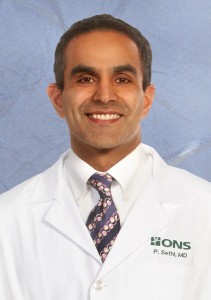Conference Preview: The Role for Stem Cells in Orthopedic Surgery

Orthopaedic Surgeon Paul Sethi, MD President, ONSF
Paul Sethi, MD will address the ACL Injuries in Women at the 6th Annual ONSF Medical Education Conference on Saturday, November 8th. Orthopedic surgeons, neurosurgeons, radiologists, sports medicine specialists, physiatrists and physical therapists will present topics related to treatment of musculoskeletal issues unique to females.
Most cells in our body develop into a specific cell type, for example cells that populate the kidneys. Similar to our staying on a “career path,” these cells stay in the same line and continue to produce and generate cells to function within the body part. In contrast, stem cells are basic human cells that have not chosen a cell type (job) but have the potential to give rise to many different cell types in the body.
This is exciting because stem cells may be able to create new cells in existing healthy tissues and may help to repair tissues in those structures that are injured or damaged.
As orthopedic surgeons, we have focused our attention on mesenchymal stem cells. Unlike embryonal stem cells, mesenchymal stem cells are obtained from living adult tissue: from bone marrow in your pelvic bone and sometimes from blood or adipose tissue. Bone marrow stromal cells are the specific mesenchymal stem cells that, in the proper environment, can differentiate into cells that are part of the musculoskeletal system. They can help to form bone, tendon, articular cartilage or even ligaments – all critical elements of musculoskeletal regeneration.
At this point, stem cell procedures in orthopedics are at an experimental stage. It is expected, however, that as more knowledge of tissue engineering is obtained, stem cell procedures will become more common. Active research and current clinical applications show promise in three specific areas of orthopedic regeneration surgery.
Bone Fractures and Nonunions: Traditionally, bone defects have been treated with solid bone, material placed at the site of the fracture or nonunion. Stem cells and progenitor cells are now placed along with the bone graft to stimulate and speed the healing. These may be used in the absence of a bone graft, avoiding a potentially painful surgical procedure.
Articular Cartilage and Arthritis: The lining of joints is called the articular cartilage. Damage to the articular cartilage can frequently lead to degeneration of the joint and painful arthritis. Current techniques treat articular cartilage damage by grafting and transplanting cartilage to fill the defects. It is hoped that stem cells, injected into the joints, will create growth of primary hyaline cartilage to restore the normal joint surface.
Ligaments and Tendons: Mesenchymal stem cells may also develop into cells that are specific to connective tissue leading to faster healing of ligament and tendon injuries, such as quadriceps or Achilles tendon ruptures. In this case, stem cells would be included as part of a primary repair process. We anticipate our future ability to repair the ACL instead of surgically replacing the ligament.
The 6th Annual ONSF Medical Education Conference will focus on treatment of musculoskeletal issues unique to females. Keynote speaker Joan Lunden, renowned author, journalist and TV host, will share her perspectives on women’s health.




